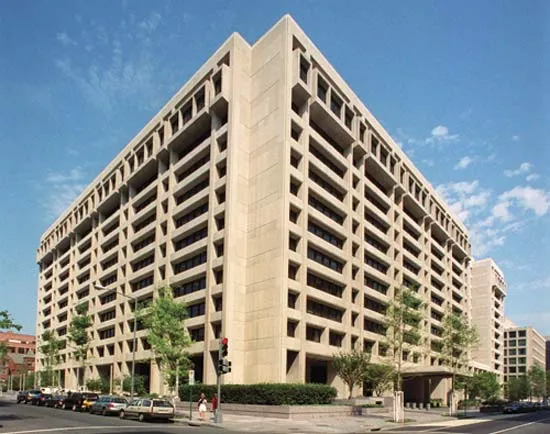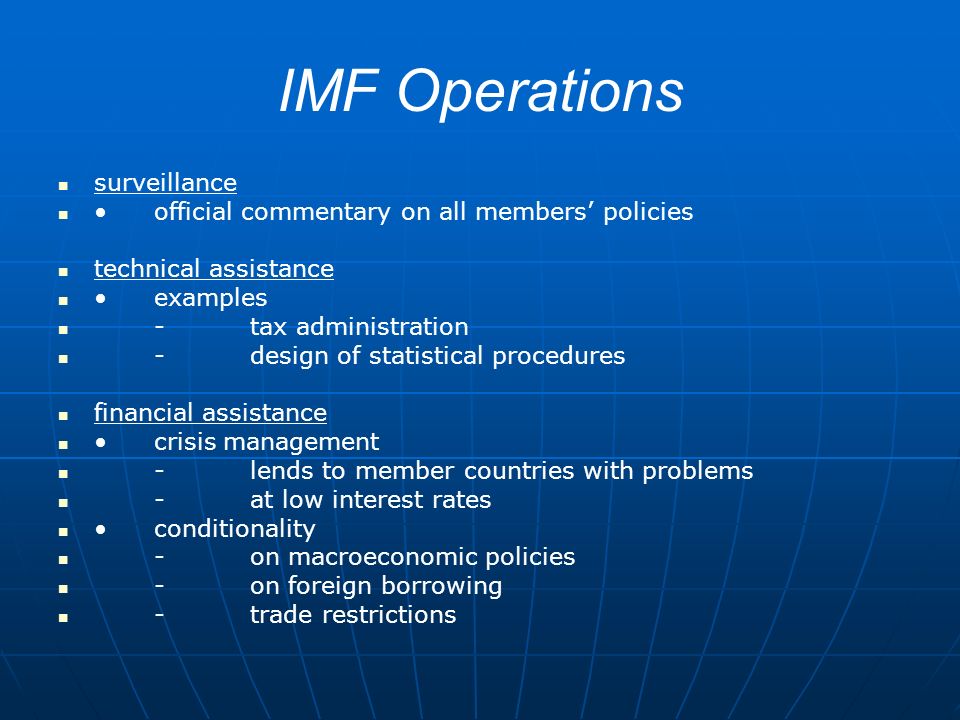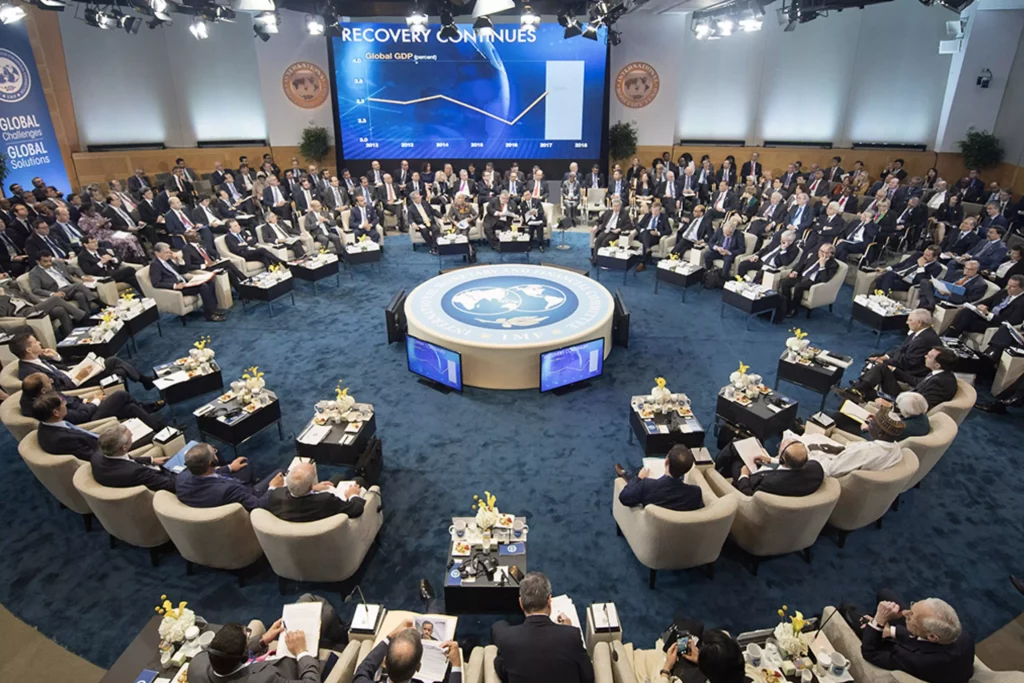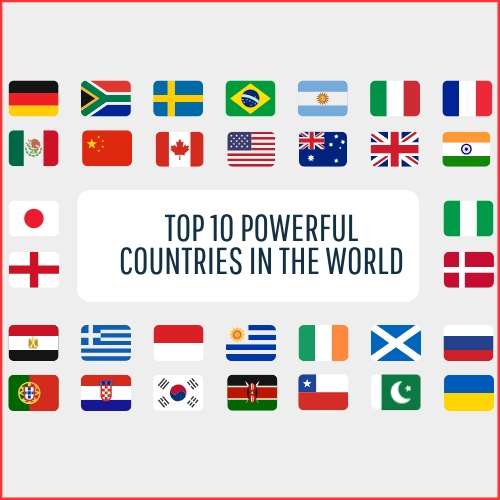Two world conflicts that devastated Europe’s physical and economic fabric and the Great Depression that devastated economies in both the United States and Europe characterize the first half of the 20th century.

These occurrences sparked a desire to establish a new global monetary order that would stabilize currency exchange rates without fully relying on gold reserves, lessen the frequency and severity of balance-of-payments deficits (occurring when more foreign currency leaves a country than it enters), and away with damaging mercantilist trade policies like competitive devaluations and foreign exchange controls—all while substantially preserving each individual country’s unique economic interests.
The United Nations Monetary and Financial Conference took place in Bretton Woods, New Hampshire, in response to multilateral talks. The planned International Monetary Fund’s Articles of Agreement, which would regulate the new global monetary system, were written by delegates from 44 different nations. By keeping convertible currencies at stable exchange rates, the architects of the new Bretton Woods monetary system hoped to foster international trade, investment, and economic expansion.
Instead of implementing exchange controls, devaluations, or deflationary economic policies that could cause their economic problems to spread to other nations, countries with temporary, moderate balance-of-payments deficits were expected to finance their deficits by borrowing foreign currency from the IMF. Organization
A board of governors, each of which represents one of the IMF’s roughly 180 member states, is in charge of the institution. The governors, who are typically the finance ministers or directors of the central banks of their nations, attend yearly meetings to discuss IMF matters.
An executive board, made up of 24 executive directors and meeting at least three times per week, oversees the fund’s daily activities. China, France, Germany, Japan, Russia, Saudi Arabia, the United Kingdom, and the United States are just a few of the specific nations represented by the fund’s other 16 directors, who are divided up into different world regions. The executive council rarely holds formal voting because it typically decides by consensus.
A managing director who is chosen by the board chairs the board. The managing director, who is chosen by the board for a five-year tenure that is renewable, chairs the board and is in charge of the fund’s 2,700 staff members from more than 140 nations. By custom, the executive director is typically a European and not an American. Christine Lagarde of France was named as the first female managing director in June 2011.
Each participant makes a financial contribution known as a quota membership. Each country’s quota is determined by its wealth and economic success and is reviewed every five years; the wealthier a country, the higher its quota. The quotas establish a stock of lendable funds and establish the borrowing limits and voting rights of each member. For instance, the United States contributes the most to the IMF of all members, at about $83 billion, or about 17% of all mandates.
As a result, the United States gets roughly 17% of the total votes on the executive board as well as the board of governors. Nearly half of the votes cast in the fund are controlled by the Group of Eight industrialized countries, which are Canada, France, Germany, Italy, Japan, Russia, the United Kingdom, and the United States.
Operation

Since its founding, the IMF has focused primarily on three tasks: stabilizing currency exchange rates, funding member countries’ short-term balance-of-payments deficits, and offering guidance and technological support to borrowing nations. rates of money exchange being stabilized
The IMF oversaw a modified gold standard system of pegged, or stable, currency exchange rates under the initial Articles of Agreement. The U.S. Treasury then tied the dollar to gold by agreeing to purchase and sell gold to other governments at a price of $35 per ounce. Each member then proclaimed a value for its currency in relation to the American dollar. A nation’s exchange rate could deviate by no more than 1% from its stated worth. In an effort to stop competitive devaluations, the IMF only allowed nations with “fundamental balance-of-payments disequilibrium” to change their exchange rates by more than 1%, and even then, only with the fund’s permission and after consultation.
Since that time, each participant has been free to select the methodology it employs to calculate its exchange rate: a free float, in which the value of a nation’s currency is decided by the demand for and supply of that currency on world currency markets; a “managed float,” in which monetary authorities from a nation occasionally purchase or sell their currency on foreign currency exchange markets to affect short-term exchange rates; a fixed exchange arrangement, in which a country’s currency exchange rate is tied to another currency and is not subject to change, as opposed to a pegged exchange arrangement, in which a country’s monetary officials promise to tie their currency’s exchange rate to another currency or group of currencies. After being stripped of its power to control foreign exchange rates.
Balance-of-payments shortfall financing

Members with balance-of-payments deficits have the option to borrow foreign currency, which they must pay back with interest, by buying the foreign currency held by the IMF with their home currencies. In this manner, each member may immediately borrow up to 25% of its quota. The available purchase amounts are expressed in Special Drawing Rights (SDRs), whose worth is determined each day by averaging the prices of the U.S. dollar, the euro, the Japanese yen, and the British pound sterling.
In order to supplement the members’ current reserve assets of foreign currencies and gold, the IMF created SDRs as a new type of international reserve asset in 1969. International obligations are settled by nations using the SDRs that the IMF has allotted to them. From 1969 to 1981, members received consecutive allocations totaling more than 20 billion SDRs. SDRs are not included in the quota subscriptions that members provide, and as a result, they are not included in the general asset pool that is accessible for member loans.
The SDR serves as the IMF’s standard unit of measure for all business dealings. A country’s use of the IMF increases the fund’s holdings of that nation’s currency while decreasing its assets of another nation’s currency by the same amount.
As a result, the fund’s resource mix varies, but its overall resource level as expressed in SDRs does not. The nation repays the debt over a predetermined time frame (typically three to five years) using IMF-acceptable member currencies.
The majority of borrowers exchange their currency for the main convertible currencies: the U.S. dollar, the Japanese yen, the euro, and the British pound sterling. Only about 20 currencies are borrowed in a typical year. Approximately 4% of the sum borrowed is paid back to the countries whose currencies are used as collateral by other member governments.
If a member experiences financial problems that force them to borrow more than 25% of their quotas, additional loans are available. The amount of the loan as well as the macroeconomic adjustments and structural reforms required to restore the country’s balance-of-payments equilibrium are determined by the IMF using an analytical framework known as financial programming, which was first fully developed by IMF staff economist Jacques Polak in 1957.
A standby arrangement, which makes short-term assistance available to countries experiencing temporary or cyclical balance-of-payments deficits, an extended-fund facility, which supports medium-term relief, a supplemental-reserve facility, which provides loans in cases of extraordinary short-term deficits, and, since 1987, a poverty-reduction and growth facility are just a few of the financing programs or facilities the IMF has available for providing these loans. Every facility has a different entry threshold, disbursement strategy, maturity structure, and repayment timetable.
The typical IMF loan, also referred to as an upper-credit tranche arrangement, has a three- to five-year repayment period, a one- to three-year maturity structure, quarterly disbursements, and a yearly access limit of 100 percent of a member’s quota. Every nation borrowing from a specific financing facility is subject to the same interest rate charged by the IMF.
The annual interest rate on loans is usually around 4.5 percent. A “letter of intent” that outlines the structural and macroeconomic changes the IMF demands as a prerequisite for assistance is provided with each of these loans. Since 1968, the Terms of the Agreement have expressly permitted “conditionality,” also known as loan terms. Common conditions demand borrowing governments. Borrowing governments are typically required to lower their budget deficits and rates of money growth, get rid of monopolies, price controls, interest rate ceilings, and subsidies, deregulate certain industries, particularly the banking industry, lower their tariffs and remove quotas, remove export barriers, keep enough international currency reserves, and devalue their currencies if they encounter fundamental balance-of-payments deficits.
These changes are meant to lower imports and boost exports so that the nation can make enough foreign currency in the future to pay off its foreign debts, including the recently acquired IMF debt. The majority of lending programs include quarterly goals for significant economic indicators that, in theory, must be reached to qualify for the next loan payment.
Advising administrations that borrow

Each member country consults with the IMF once a year. The IMF makes an assessment of each nation’s economic situation and works to avert potential financial issues through these interactions, also known as “Article IV Consultations.” The IMF Institute is a division of the fund that trains officials from member nations in macroeconomic research and policy formulation.
Critique and discussion

IMF funds’ effects have been hotly contested. IMF critics contend that the loans give members the freedom to adopt risky domestic economic policies in the knowledge that, in an emergency, the IMF will provide financial support. Critics claim that this safety net delays necessary changes and fosters long-term dependency. Additionally, detractors claim that by saving foreign financiers who made bad loans, the IMF is encouraging them.
Conditions imposed by the IMF have also been hotly contested. IMF policy recommendations, according to critics, offer uniform solutions that are insufficiently customized to each country’s particular situation. The borrower countries’ poorest citizens experience extreme hardship as a result of these standard, stringent loan conditions, which also deepen and prolong financial crises and increase local resistance to the IMF.















